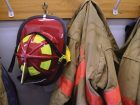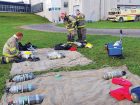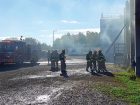
News
Trainer’s Corner: June 2019
There are times after practice when a few of the members linger in the training room. Inevitably the coffee pot gets brought over to the desk and we attempt to fix all the wrongs in the world.
May 15, 2019
By Ed Brouwer
I value those times. Sometimes we even talk about fire-related subjects, no real surprise there.
Several weeks ago, we got to talking about our practices. Our members have completed all the courses and subject matter required by our city’s mandate for fire service. As we spoke about what was next, I glanced over at our Certification Wall. Ninety-per-cent of the training certificates had all the subjects adorned with a red sticker (signifying successful completion).
Then I heard one of our young guns ask, “So now what? Do we do it all again with blue stickers?”
I laughed, but realized he had a good point. Our members had studied all the topics diligently, and they successfully completed both the written exams and skill tests for each core skill.
Over the past two years, they completed all our province’s requirements and were now in full compliance with B.C.’s Firefighter Playbook as Exterior Operations Level Firefighter.
I looked at my young friend and asked, “What do you want to do?” He answered by telling me that he was dreading having to do the same courses over and over again.
He went on to say it was exciting when we first set the training goals to achieve this certification. He told me he could hardly wait for practice night then because he was going to learn something new. But now to do it all over again, he admitted, is boring. I admit, I agreed with him.
I think the biggest hurdle for today’s training officer is not the subject matter, but rather keeping our members engaged in the training. It is one thing to have an in-house training certification program, but once it is completed where do you go next?
I would love to hear from some of you who’ve dealt with this issue. As well, if you have discovered a way to keep your members engaged in ongoing training please drop me a line. Perhaps we can share those ideas in a future column.
I tried something at our last practice that seemed to work. I divided the members into three groups. After I assigned a different topic to each group, I described the “three Ds” of core skill training, which are demonstrate, describe and do.
The demonstrate part is simply demonstrating to the students the particular core skill you are teaching. For example, if your objective is to get each member to properly don their PPE, you would (after getting their attention) simply don your PPE. You don’t speak, you simply don your gear. When you are done, you doff your gear and set it aside.
The describe part is the very same thing. However, while you are donning your gear you are describing each step as you are doing it. Each step is verbalized, by yourself or an assistant.
Once your gear has been donned and doffed, you now get each of your members to do. In this example, each member dons and doffs their own gear.
If you have been a trainer for any length of time at all, you will have certainly heard the saying, “I hear – I forget, I see – I remember, I do – I understand.” This statement is perfect in this scenario.
Getting back to our practice night, as I said I established three groups and assigned one topic to each. We were bringing some rookies up into the ranks, so I kept the subjects along the lines of rookie training. But you can use any subjects you want, keeping in mind you want to give each group about 15 to 20 minutes to prepare their subject. Each session should be roughly 20 minutes in length. With three groups it works out to a 90-minute practice night.
The three topics I used were, donning and doffing SCBA, deploying and loading a minuteman hose lay, and using a handheld radio on the fire ground.
The groups were given 20 minutes to get set to use the three Ds in teaching their subject. When all the groups were ready, group one taught groups two and three their core skill. When all the members had completed the “do” part we moved on to group two’s core skill. Now groups one and three were the students.
Again, when the “do” part was successfully completed, group three presented its core skill. This left group one and two as the students.
It was a full night to be sure. But no one was bored. Each and every member participated in the practice. (Well I didn’t do too much – I had a coffee while I watched). I tried not to interfere with any part of the three Ds, unless it was an obvious safety issue. All in all, it was a productive practice with 100-per-cent engagement.
This worked so well I tried it three weeks later. The core skill topics this time were SCBA bottle change, two hose rolls (their choice), and arrival reports. The latter was demonstrated as a skit.
The thing I think you will like about these core skill sessions is that there is virtually no prep time on your part, and you are guaranteed membership engagement. A win-win.
Now, just in case no one has told you lately – your commitment to the Canadian fire services as a trainer is very much appreciated. I am proud to be named among you.
I have said it before, but it bears to be repeated – in my humble opinion the training officer is the highest calling in the fire service. Keep up the excellent work and please remember to train like lives depend on it, because they most certainly do.
Ed Brouwer is the chief instructor for Canwest Fire in Osoyoos, B.C., deputy chief training officer for Greenwood Fire and Rescue, a fire warden, wildland urban interface fire-suppression instructor and ordained disaster-response chaplain. Contact Ed at aka-opa@hotmail.com.
Print this page


